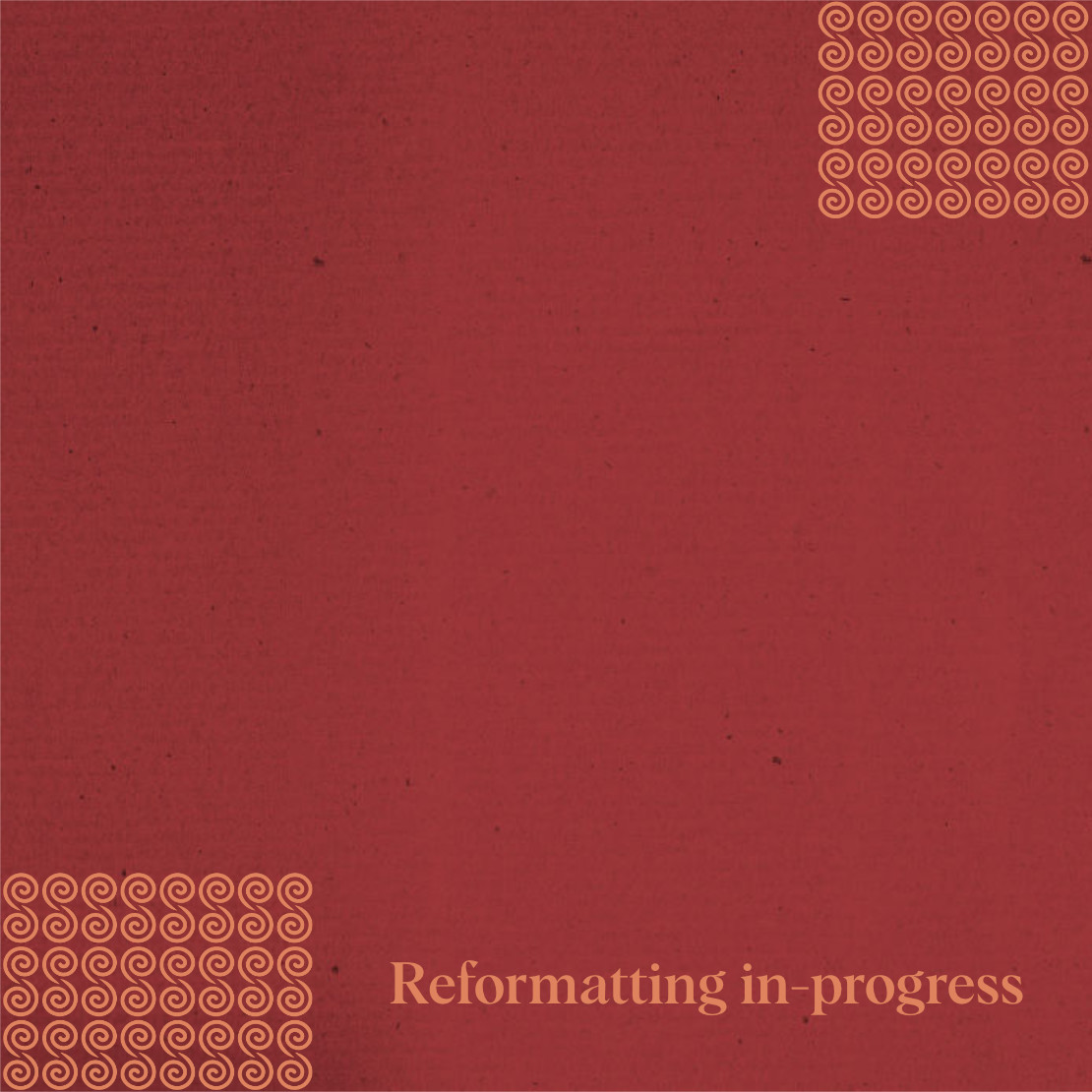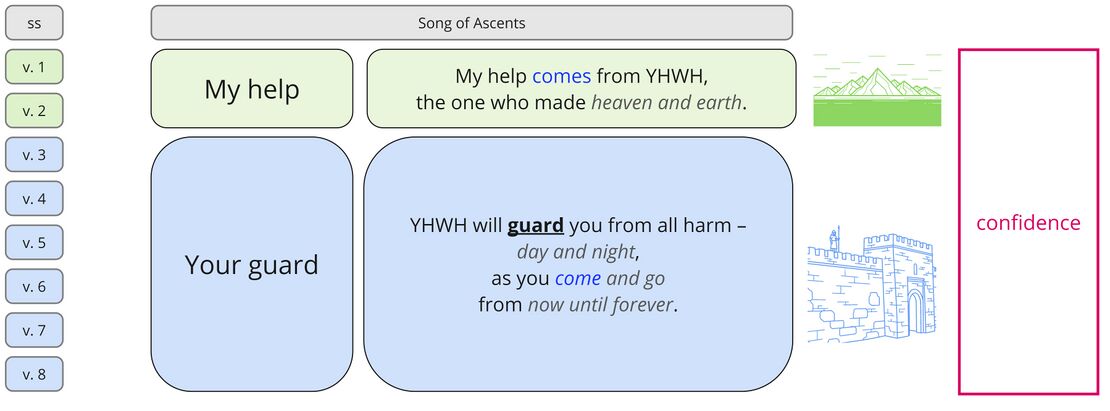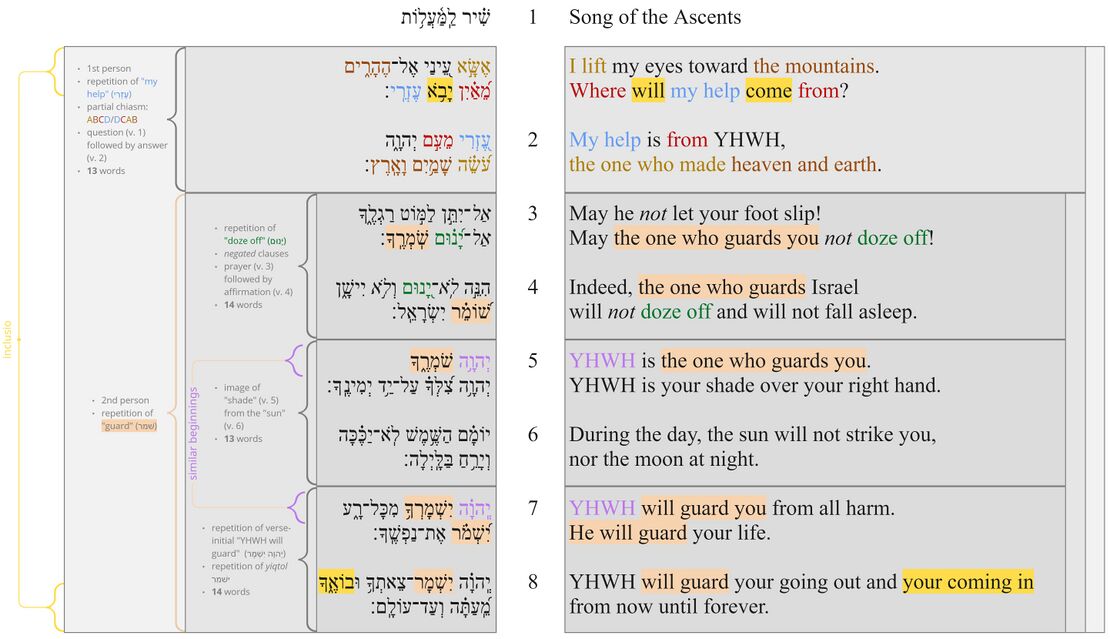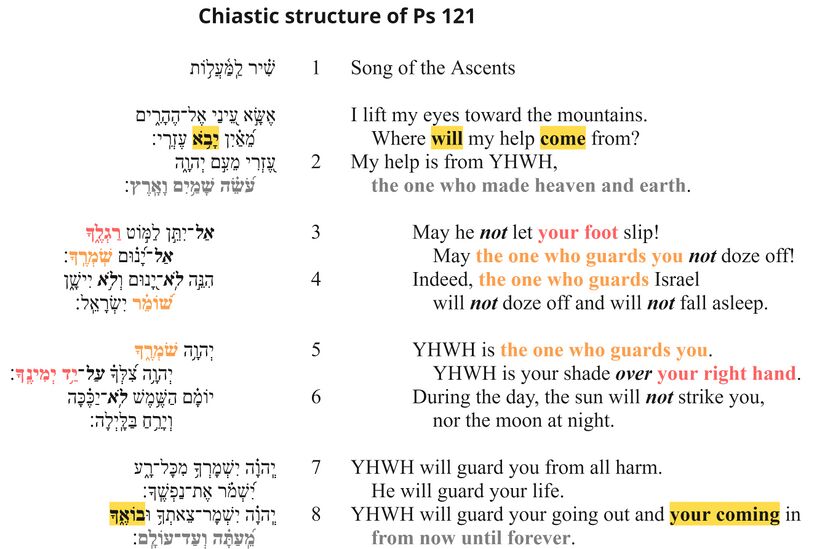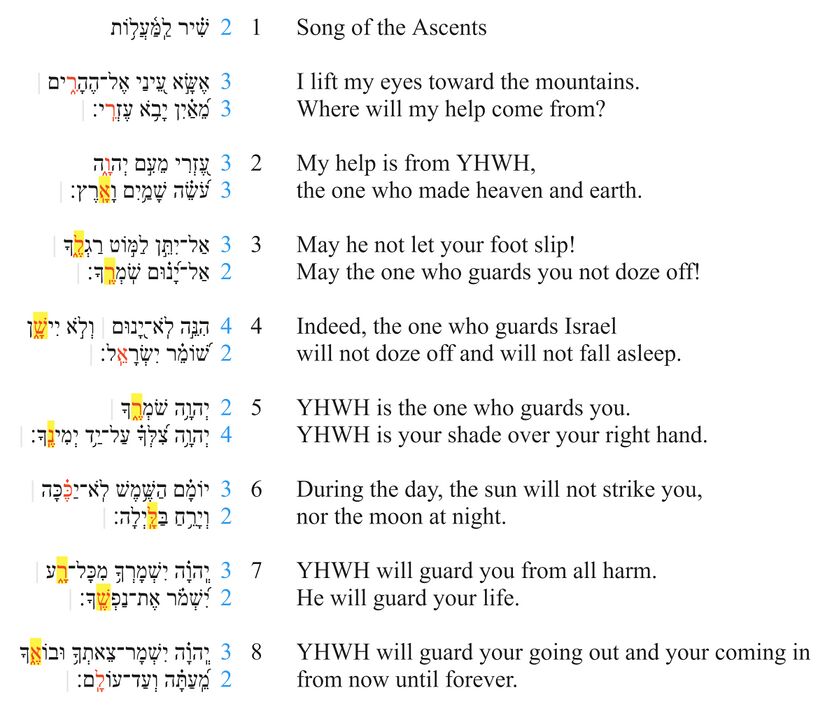Psalm 121 Poetic Structure
Poetic Structure
In poetic structure, we analyse the structure of the psalm beginning at the most basic level of the structure: the line (also known as the “colon” or “hemistich”). Then, based on the perception of patterned similarities (and on the assumption that the whole psalm is structured hierarchically), we argue for the grouping of lines into verses, verses into sub-sections, sub-sections into larger sections, etc. Because patterned similarities might be of various kinds (syntactic, semantic, pragmatic, sonic) the analysis of poetic structure draws on all of the previous layers (especially the Discourse layer).
Poetic Macro-structure
If an emendation or revocalization is preferred, that emendation or revocalization will be marked in the Hebrew text of all the visuals.
| Emendations/Revocalizations legend | |
|---|---|
| *Emended text* | Emended text, text in which the consonants differ from the consonants of the Masoretic text, is indicated by blue asterisks on either side of the emendation. |
| *Revocalized text* | Revocalized text, text in which only the vowels differ from the vowels of the Masoretic text, is indicated by purple asterisks on either side of the revocalization. |
Notes
- The poem is bound by an inclusio (בוא, vv. 1, 8) and united by the common theme of YHWH's protection, exemplified by the key word "guard" (שׁמר), which appears six (!) times (vv. 3–8). Although the word "guard" does not appear in vv. 1–2, it is closely related to the idea of "help" – both words involve protection from danger – and to the image of "lifting one's eyes" – the basic meaning of שׁמר is to "watch" (see lexical semantics).
- There are 54 words in the poem, corresponding to the numerical value of the key-word "guard" (שׁמר).[1] (Note that this word count disregards the maqqefs in the Masoretic Text and counts each individual grapheme as its own word.)
- Shin = 21 (21st letter of the alphabet);
- Mem =13 (13th letter of the alphabet);
- Resh = 20 (20th letter of the alphabet)
- The psalm divides into two main parts: vv. 1–2 and vv. 3–8.[2] Two features support this structure:
- The key-word word שׁמר only occurs in vv. 3–8, not in vv. 1–2.
- There is a shift in person between vv. 1–2 (first person) and vv. 3–8 (second person). For the significance of this shift, see The Voice(s) in Psalm 121.
- Others argue plausibly that the psalm divides into two halves (vv. 1–4; vv. 5–8), with each half consisting of eight lines and 27 words.[3] Under this schema, the first half is bound by a similar pattern of question/prayer (irrealis) (vv. 1, 3) followed by confident affirmation (realis) (vv. 2, 4).[4] Another feature that binds this first half according to this schema is the use of link-words to unite the sub-sections: עֶזְרִי in vv. 1b–2a and יָנוּם in vv. 3b–4a. The second half according to this schema is bound by the repetition of "YHWH is the one who guards you" // "YHWH will guard you" at the beginning of vv. 5, 7.
- The second main part (vv. 3–8) subdivides into three parts, thus creating four sub-sections throughout the psalm (vv. 1–2, vv. 3–4, vv. 5–6, vv. 7–8).[5] Each sub-section is about the same length (4 lines and 13 words / 4 lines and 14 words / 4 lines and 13 words / 4 lines and 14 words).
- The first sub-section (vv. 1–2) is bound by the repetition of "my help" (עֶזְרִי), which is actually part of a larger chiasm in these verses: A. "I lift" (אשא); B. "the mountains"; C. "from where"; D. "my help" // D. "my help"; C. "from YHWH"; A. "maker" (עשה , sounds similar to אשא); B. "heaven and earth" (related to "mountains" – all are cosmological terms; also mountains stand in between heaven and earth).
- The second sub-section (vv. 3–4) is bound by the repetition of the rare word "doze off" (יָנוּם). The use of negators ("not...not...not...not") also binds these verses together.
- The third sub-section (vv. 5–6) is bound by its imagery: the "shade" mentioned in v. 5 gives protection from the "sun" mentioned in v. 6.
- The fourth sub-section (vv. 7–8) is bound by the especially dense repetition of ישׁמר (yiqtol), which occurs in every clause. The two verses in this section also have the same beginning: יְהוָה יִשְׁמָרְ.
- These four sub-sections are also arranged as a chiasm, uniting the whole poem.[6]
- The first sub-section (vv. 1–2) corresponds to the last sub-section (vv. 7–8) through the repetition of the word "come" (בוא) as well as the similarities between final lines of these section: "the one who made heaven and earth" and "from now until forever." Both of these phrases are merisms. Also, both phrases are instances of enjambment that conclude a sub-section.
- The middle sections (vv. 3–4 and vv. 5–6) correspond to one another by the repetition of the participle שׁומר (vv. 3b, 4b, 5a), the use of negators (vv. 3–4, 6; note also עַל in v. 5, which sounds similar, though not identical to, the negator אַל), and the mention of body parts (v. 3: "your foot"; v. 5: "your right hand").
Line Divisions
Line division divides the poem into lines and line groupings. We determine line divisions based on a combination of external evidence (Masoretic accents, pausal forms, manuscripts) and internal evidence (syntax, prosodic word counting and patterned relation to other lines). Moreover, we indicate line-groupings by using additional spacing.
When line divisions are uncertain, we consult some of the many psalms manuscripts which lay out the text in lines. Then, if a division attested in one of these manuscripts/versions influences our decision to divide the text at a certain point, we place a green symbol (G, DSS, or MT) to the left of the line in question.
| Poetic line division legend | |
|---|---|
| Pausal form | Pausal forms are highlighted in yellow. |
| Accent which typically corresponds to line division | Accents which typically correspond to line divisions are indicated by red text. |
| | | Clause boundaries are indicated by a light gray vertical line in between clauses. |
| G | Line divisions that follow Greek manuscripts are indicated by a bold green G. |
| DSS | Line divisions that follow the Dead Sea Scrolls are indicated by a bold green DSS. |
| M | Line divisions that follow Masoretic manuscripts are indicated by a bold green M. |
| Number of prosodic words | The number of prosodic words are indicated in blue text. |
| Prosodic words greater than 5 | The number of prosodic words if greater than 5 is indicated by bold blue text. |
If an emendation or revocalization is preferred, that emendation or revocalization will be marked in the Hebrew text of all the visuals.
| Emendations/Revocalizations legend | |
|---|---|
| *Emended text* | Emended text, text in which the consonants differ from the consonants of the Masoretic text, is indicated by blue asterisks on either side of the emendation. |
| *Revocalized text* | Revocalized text, text in which only the vowels differ from the vowels of the Masoretic text, is indicated by purple asterisks on either side of the revocalization. |
Notes
- The division of this psalm into lines is relatively straightforward. The division above agrees with the Masoretic accents,[7] the pausal forms, and the Septuagint (according to Rahlfs 1931).
- There is enjambment in vv. 2, 4, 8, each time at the end of a poetic unit (see Poetic Structure).
- ↑ cf. Labuschagne, cited in van der Lugt 2013, 352.
- ↑ See e.g., Emmendörffer 2025; Fokkelman 2000, 271; cf. Auffret 1999, 13–23; Maré 2006.
- ↑ E.g., van der Lugt 2013, 350.
- ↑ See Creach 1996, 49–50; cf. van der Lugt 2013, 354.
- ↑ Cf. Weber 2016, 278–280; Zenger 2011, 319–320.
- ↑ cf. Weber 2016, 279–280.
- ↑ Cf. de Hoop and Sanders 2022.
